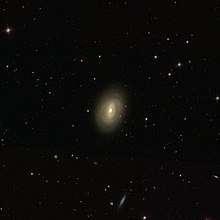NGC 3626
NGC 3626 (also known as Caldwell 40) is a medium-tightness spiral galaxy and Caldwell object in the constellation Leo. It was discovered by William Herschel, on 14 March 1784. It shines at magnitude +10.6[1]/+10.9. Its celestial coordinates are RA 11h 20.1m, dec +18° 21′. It is located near the naked-eye-class A4 star Zosma, as well as galaxies NGC 3608, NGC 3607, NGC 3659, NGC 3686, NGC 3684, NGC 3691, NGC 3681, and NGC 3655. Its dimensions are 2′.7 × 1′.9.[1] The galaxy belongs to the NGC 3607 group some 70 million light-years distant, itself one of the many Leo II groups.[2]
| NGC 3626 | |
|---|---|
 SDSS image of NGC 3626 | |
| Observation data | |
| Constellation | Leo |
| Right ascension | 11h 20m 03.8s |
| Declination | +18° 21′ 25″ |
| Redshift | 1,493 km/s |
| Distance | 70 million ly |
| Apparent magnitude (V) | +10.6/+10.9 |
| Characteristics | |
| Type | Sb (S0/Sa) |
| Apparent size (V) | 2′.7 × 1′.9 (3′) |
| Other designations | |
| Caldwell 40 | |
Notes
- Erdmann, Jr., Robert E. (1996–2008). "Object Data". The NGC / IC Project. Retrieved 2008-08-11.
- Powell, Richard (2006). "The Leo II Groups". Atlas of The Universe. Retrieved 2008-08-11.
gollark: For 1000% efficiency, which is good.
gollark: I know a decent amount about NC reactor design, but focus on the "horrendously oversized" sort.
gollark: We could put fluxducts on poles or something.
gollark: Not really.
gollark: I was thinking about designing tunnels which we can also run rails and, say, water lines in.
References
- Bratton, Mark (2011). The Complete Guide to the Herschel Objects. Cambridge University Press. ISBN 978-0-521-76892-4.
- Pasachoff, Jay M. (2000). "Atlas of the Sky". Stars and Planets. New York, NY: Peterson Field Guides. ISBN 978-0-395-93432-6.
- Caldwell-Moore, Sir Patrick (2003). Firefly Atlas of the Universe. Firefly Books Limited. ISBN 978-1-55297-819-1.
External links

- NGC 3626 on WikiSky: DSS2, SDSS, GALEX, IRAS, Hydrogen α, X-Ray, Astrophoto, Sky Map, Articles and images
- Frommert, Harmut. "Revised NGC Data for NGC 3626". Spider. Students for the Exploration and Development of Space.
- "NGC 3626". SIMBAD. Centre de données astronomiques de Strasbourg.
- "NED results for object NGC 3626". NASA/IPAC Extragalactic Database. National Aeronautics and Space Administration / Infrared Processing and Analysis Center.
This article is issued from Wikipedia. The text is licensed under Creative Commons - Attribution - Sharealike. Additional terms may apply for the media files.